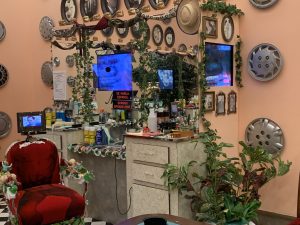By Adriana Vélez
Initially, I was not expecting much from my visit to the Museum of Art of Puerto Rico. As someone who was born and raised on the island yet hadn’t visited the museum in years, I expected the museum’s collection to be mostly composed of the kind of art that one would see at artisanal fairs and regional festivals. These artworks usually include depictions of traditional jíbaros, piragüeros, the Three Wise Men, and sugar cane factories. However, I was greeted by an impressive and diverse collection of artworks that put my initial biases to shame.
My first reaction was an audible gasp upon entering Pepón Osorio’s No Crying Allowed in the Barber Shop, one of the installation rooms located on the second floor of the institution. Peach-colored walls, black and white checkered flooring, and an unbelievable amount of meticulously placed, decorative objects created an overwhelming sense of nostalgia for the aesthetic of the 1950’s in Puerto Rico.

The exhibition, which was created in 1994, represents the “nostalgia of the people who live outside their homeland through an immense catalog of objects that refer to the collective imaginary of migrants”, as well as “the signs and symbols of machismo – [and the] indispensable requirement to be 100% macho”.

The room is designed to replicate the look of an old school barbershop and includes traditional, red velvet barber chairs, vintage beauty products, and decorated, mirrored stations. Small TV screens replace the headrests on the barber chairs while others are attached to the mirrors. They play videos on loop of traditionally male imagery, such as weight-lifting, the ritualistic action of buttoning a shirt over a gold chain, a little boy getting his first haircut. The walls are decorated with wheel covers as a nod to the “cult of cars” and framed pictures of famous Puerto Rican men, like Roberto Clemente. In addition, the wall is decorated with the painted phrase “Perdoname Madre” in big, cursive letters, which flanks the illustration of a traditional rose tattoo and three bullets. A large billiard table is placed in the center of the room and to its right, there is a life-sized statue of Saint Lazarus, who is an important religious figure in Afro Caribbean Santeria. Other areas of the room are filled up with red velvet chairs, simulating the barber shop’s waiting room.

As I mentioned before, I was blown away by the installation room. The colorful, vintage aesthetic stands out from the museum’s other exhibitions, especially because of the walls and flooring which are white and grey throughout the rest of the museum. In terms of visual content, I have no critiques. The installation effectively creates an immersive experience that transports me back to my grandparents’ time. As an exhibition space, I was disappointed to not be able to get closer to the barber’s stations and see the beauty products and decorations more up close. The public is cut off from the second half of the room and can only get as close as the billiard table permits us. It feels like a waste for those details to go unnoticed after all the time and effort that went into placing them. However, I changed my mind after some thinking. The inaccessible area of the installation creates a mise-en-scène, which refers to the stage design and arrangement of actors in scenes in narrative storytelling. This further begs the question, is masculinity and machismo an act presented for others? I’m sure we all know the answer.

I strongly believe that celebration without critique is counterproductive. By upholding and exalting machismo culture, we continue to perpetuate the broken sociocultural systems that are so prevalent in our collective Hispanic culture. Earlier this year, the Governor of Puerto Rico finally announced a state of emergency in regards to the rampant increase of gender-based violence and murders that have happened over the last couple of years. Moreover, the country was essentially at a stop the day I went to the museum, May 2, due to the horrific disappearance of a pregnant, 27 year-old woman who was suspected to have been murdered by her partner of eleven years and the appearance of a woman’s burnt body which had been found during a search for the previous victim.

One must also take into account the date of production, 1994, and the sociocultural differences between these times. While No Crying Allowed on the Barber Shop has the undertone of a critique towards machismo, it does not feel like enough in the current political climate.